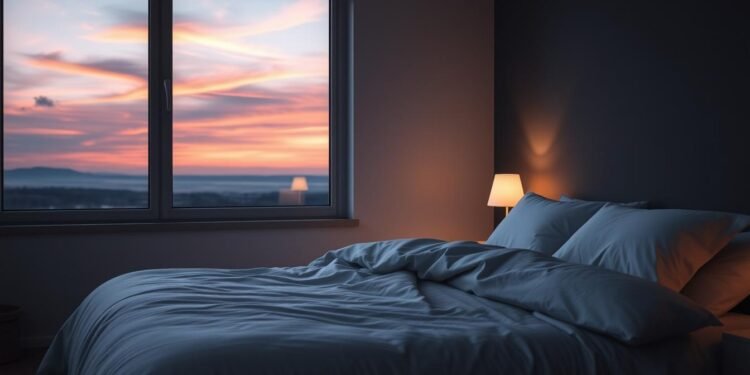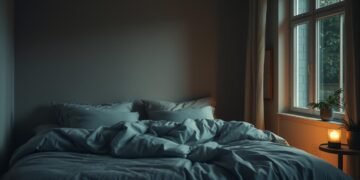Have you ever wondered why you feel tired even after a full night’s rest? The answer might lie in your daily habits. A consistent routine is key to improving your overall well-being, and it starts with your circadian rhythm.
We’ve created a 14-day plan designed to help you realign your internal clock. This approach is backed by research from the Sleep Foundation and the Cleveland Clinic, ensuring it’s both effective and science-based.
Common issues like weekend oversleeping or relying on caffeine can disrupt your rhythm. Our plan addresses these challenges through three actionable phases: circadian realignment, optimizing your environment, and reinforcing a sustainable routine.
By following this guide, you’ll not only improve your rest but also enhance your overall health. Ready to take the first step? Let’s dive in.
Key Takeaways
- A 14-day plan helps reset your circadian rhythm effectively.
- Consistent patterns improve overall health and well-being.
- Backed by research from the Sleep Foundation and Cleveland Clinic.
- Addresses common issues like oversleeping and caffeine dependence.
- Includes actionable phases for long-term success.
Why Resetting Your Sleep Schedule Matters
Your body’s internal clock plays a bigger role in your health than you might think. When it’s out of sync, it can lead to hormonal imbalances and increased inflammation. These biological costs are just the tip of the iceberg.
Chronic sleep deprivation has been linked to serious conditions like heart disease, diabetes, and weakened immunity. According to the Cleveland Clinic, 40% of Americans experience some form of rest deficiency, which can have long-term consequences.
Dr. Foldvary-Schaefer, a leading expert, emphasizes that proper alignment of your internal rhythm is foundational for cognitive function and emotional regulation. Staying awake for 20+ hours can impair your decision-making as much as a 0.08 BAC level.
Short-term fatigue might seem manageable, but the long-term risks to your body and mind are significant. By prioritizing consistency, you can protect your health and enhance your daily performance.
Understanding Your Circadian Rhythm
Your daily energy and focus are deeply tied to your internal clock. This natural rhythm, known as the circadian rhythm, regulates when you feel alert and when you need rest. It’s controlled by a tiny region in your brain called the suprachiasmatic nucleus (SCN).
The SCN contains about 20,000 neurons that manage your 24-hour cycles. These cycles influence everything from hormone release to body temperature. When your rhythm is aligned, you feel more energized and productive.
How Light Exposure Affects Your Sleep
Light plays a critical role in regulating your circadian rhythm. Morning sunlight, for example, can increase cortisol levels by 50% within 30 minutes. This helps you wake up feeling refreshed and ready for the day.
On the other hand, artificial light, especially blue light from screens, can suppress melatonin production by 23%. This makes it harder to wind down at night. To maintain balance, aim for 2,500 lux of light in the morning and less than 100 lux in the evening.
Research from MIT shows that just 15 minutes of morning light can advance your rhythm by 30 minutes. Timing your exposure correctly can make a significant difference in how you feel throughout the day.
Common Causes of Sleep Schedule Disruptions
Many factors can throw off your daily rhythm, leaving you feeling out of sync. These disruptions often fall into five categories: environmental, chemical, behavioral, biological, and psychological. Understanding these can help you take steps to restore balance.
Stress is a major culprit. According to the Sleep Foundation, 68% of adults lose at least one hour of rest weekly due to stress. High stress levels trigger cortisol release, leading to shallow rest and a vicious cycle of more stress.

Chemical factors like caffeine also play a role. Evening caffeine can delay rest onset by 40 minutes, as shown in the Journal of Clinical Sleep Medicine. Shift workers face unique challenges, with insomnia rates three times higher than average.
Chronotype mismatches affect 30% of the population, meaning their natural rhythms don’t align with standard schedules. Additionally, evening screen time can reduce rest duration by 38 minutes after just two hours of use.
By identifying these disruptions, you can take proactive steps to protect your system and improve your daily rhythm. Small changes can make a big difference in how you feel.
How to Reset Your Sleep Schedule in 14 Days
Taking control of your daily rhythm can transform how you feel and function. Our 14-day plan is designed to help you fix sleep schedule issues step by step. By following this structured approach, you’ll create a routine that supports your overall well-being.
Day 1-3: Setting a Consistent Wake-Up Time
The first phase focuses on establishing a fixed wake-up time. Research from the Cleveland Clinic shows that consistent wake times improve efficiency by 17%. Start with a military-style protocol: wake up at the same time every day, even on weekends.
Pair this with light therapy to signal your brain that it’s time to start the day. Morning light exposure can help reset your internal clock and boost alertness.
Day 4-7: Gradually Adjusting Your Bedtime
Next, work on shifting your bedtime gradually. Make 22-minute adjustments each night to avoid feeling overwhelmed. Incorporate wind-down rituals like reading or meditation to prepare your body for rest.
This phase helps your system adapt to the new routine without causing stress or fatigue. Consistency is key to long-term success.
Day 8-14: Reinforcing Your New Routine
In the final phase, focus on optimizing your environment and stacking habits. Ensure your bedroom is cool, dark, and quiet. Use habit stacking techniques to link your new routine with existing habits, like brushing your teeth before bed.
For shift workers or parents, troubleshooting tips include using blackout curtains and adjusting meal times to align with your new rhythm. A printable progress tracker can help you stay on course.
By the end of 14 days, you’ll have a sustainable routine that supports your health and energy levels. Small, consistent changes can make a big difference in how you feel every day.
Sleep Hygiene Tips for Better Rest
Improving your rest starts with small, intentional changes to your daily habits. By focusing on sleep hygiene, you can create a routine that supports your overall well-being. Let’s explore practical steps to enhance your rest quality.
Creating a Sleep-Friendly Environment
Your surroundings play a crucial role in how well you rest. Start by optimizing your sleep environment. Aim for a bedroom temperature of 65°F, as recommended by the Sleep Foundation. This helps your body maintain its natural rhythm.
Sound and texture also matter. Keep noise levels below 30dB and choose bedding with a thread count of 600 or higher. Separating your sleep and work areas can further enhance focus and relaxation. Adding aromatherapy, like 2% lavender oil diffusion, can create a calming atmosphere.
Limiting Caffeine and Alcohol
What you consume can significantly impact your rest. Reduce caffeine intake gradually, cutting back by 25mg every three days. This helps your body adjust without withdrawal symptoms.
Evening alcohol consumption can reduce REM rest by 24%, according to the National Institute on Alcohol Abuse. Limit drinks to one per 25kg of body weight, and avoid consumption after 7pm. These small adjustments can make a big difference in how you feel.
The Role of Melatonin in Sleep Regulation
Melatonin, a natural hormone, plays a pivotal role in regulating your daily rhythm. Produced in the pineal gland, it helps signal to your body when it’s time to wind down. This process begins with tryptophan, an amino acid that converts into serotonin and then into melatonin.

You can boost melatonin levels through food or supplements. Tart cherries, for example, are a natural source. However, timed-release tablets are often more effective for specific needs. The Mayo Clinic recommends 0.3mg to mimic natural production, while higher doses like 5mg are used for disorders.
Timing is crucial. Taking melatonin four hours before your Dim Light Melatonin Onset (DLMO) can help align your rhythm. This is especially useful for phase shifts, such as adjusting to a new time zone.
While melatonin is generally safe, overuse can lead to dependency or next-day grogginess. To avoid this, follow a clinical protocol: use it in three-day cycles with four-day breaks. This approach ensures your body doesn’t rely on external sources.
By understanding how melatonin works, you can make informed choices to support your rest and overall well-being. Small adjustments can lead to significant improvements in how you feel every day.
Light Therapy: A Tool for Sleep Schedule Reset
Light therapy is a powerful tool to help realign your internal clock. By using specific light intensities, you can improve your circadian rhythm and feel more energized throughout the day. Research from Sleep Medicine Reviews shows that 10,000 lux light boxes can improve rest latency by 33%.
Morning light exposure is particularly effective. It can advance your rhythm by one hour per day, making it easier to wake up and stay alert. For best results, use a light box for 20 minutes upon waking, positioned 24 inches away.
When choosing equipment, consider LED vs. fluorescent units and vertical vs. angled designs. LED units are energy-efficient, while fluorescent models are often more affordable. Vertical units are ideal for desk use, while angled ones are better for reading or working.
Light therapy isn’t suitable for everyone. Contraindications include bipolar disorder, retinopathy, and photosensitivity. If you’re traveling, use a time zone calculator to adjust treatment timing and minimize jet lag.
Cost is another factor to consider. Devices typically range around $150, but natural light strategies, like spending time outdoors in the morning, can be equally effective. Weigh the benefits to find the best option for your needs.
By incorporating light therapy into your routine, you can take a proactive step toward improving your daily rhythm and overall well-being. Small changes can lead to significant improvements in how you feel every day.
When to Seek Professional Help
When self-help strategies fall short, professional guidance can make a difference. If you’ve tried various methods to improve your daily rhythm without success, it might be time to consult an expert. Chronic issues often require specialized intervention to address underlying causes effectively.
Recognizing red flag symptoms is the first step. If you consistently take more than 30 minutes to fall asleep or get less than six hours of rest three times a week, these are signs to seek help. Such patterns can significantly impact your health and daily functioning.
The diagnostic process typically starts with a sleep diary, followed by actigraphy and polysomnography. These tools help specialists pinpoint the root cause of your sleep disorders. Understanding your condition is crucial for creating a tailored treatment plan.
Insurance coverage can vary, but most plans include CPT codes 95800-95811 for diagnostic tests. We recommend checking with your provider to understand your benefits. For specialist options, consider AASM-certified centers or telemedicine platforms for convenience.
In some cases, pharmaceutical alternatives like dual orexin antagonists or traditional hypnotics may be necessary. These are typically considered after non-pharmacological approaches, such as CBT-I, which improves efficiency by 30% in just four weeks.
Taking the step to seek professional help can transform your well-being. With the right guidance, you can regain control of your daily rhythm and improve your overall health in a matter of days.
Conclusion
Embarking on a 14-day journey to improve your daily rhythm can set the stage for lasting health benefits. This plan is your foundation for better sleep quality and overall well-being. After completing the initial phase, we recommend a 90-day habit consolidation period to solidify your progress.
To support your journey, we’ve created downloadable resources, including dark mode app settings and circadian-friendly recipes. These tools will help you maintain your new routine effortlessly.
As Dr. Cotliar wisely said, “Small changes create big impacts.” Every step you take matters. For ongoing support, join our sleep care community and continue prioritizing your health.
Take the first step today and transform your time into a more energized and balanced life.
FAQ
Why is it important to maintain a consistent bedtime and wake-up time?
Keeping a regular routine helps align your body’s internal clock, making it easier to fall asleep and wake up naturally. This consistency supports better rest and overall health.
How does light exposure influence my body’s rhythm?
Light, especially natural sunlight, signals your brain to stay awake during the day and promotes melatonin production at night. Managing light exposure can help regulate your sleep-wake cycle.
What are some common factors that disrupt rest patterns?
Stress, irregular routines, caffeine, and alcohol can interfere with your ability to fall asleep or stay asleep. Addressing these factors can improve your rest quality.
How can I create a rest-friendly environment?
Keep your bedroom cool, dark, and quiet. Remove distractions like screens and invest in comfortable bedding to enhance your rest experience.
What role does melatonin play in regulating rest?
Melatonin is a hormone that signals to your body when it’s time to rest. Its production increases in the evening, helping you wind down and prepare for a good night’s rest.
When should I consider seeking professional help for rest issues?
If you’ve tried adjusting your routine and environment but still struggle with rest deprivation or disorders, it’s wise to consult a healthcare provider for personalized guidance.




